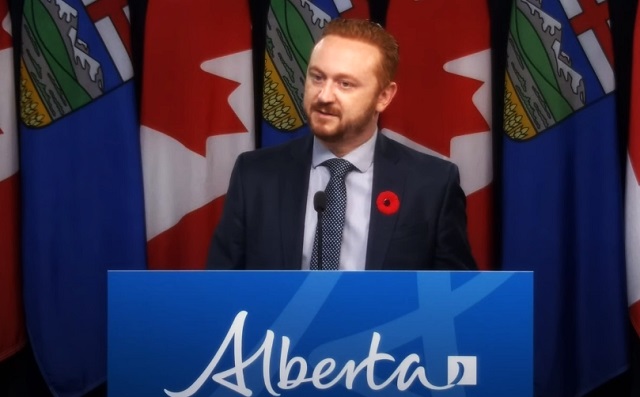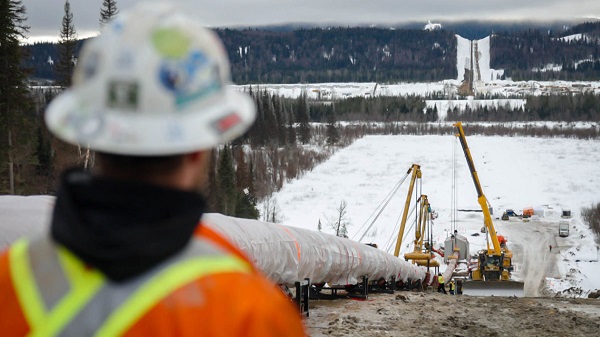Alberta
Alberta seeks to strip unelected officials of decision-making power during health emergencies

Alberta Justice Minister and Attorney General Mickey Amery
From LifeSiteNews
Bill 6 would prevent the province’s medical officer from having sole power to lock people down in their houses or mandate vaccines
Alberta’s United Conservative Party (UCP) government under Premier Danielle Smith is looking to pass a new law that would hold politicians accountable in times of a health crisis by putting sole decision-making on them for health matters instead of unelected medical officers.
Last Tuesday, Bill 6, or the Public Health Amendment Act, was tabled for first reading in Alberta’s legislature by Justice Minister and Attorney General Mickey Amery.
The bill comes in direct response to a recent court ruling that declared certain public health orders effectively null.
At the end of July, Justice Barbara Romaine from Alberta’s Court of Kings Bench ruled that politicians violated the province’s health act by making decisions regarding COVID mandates without authorization.
The decision put into doubt all cases involving those facing non-criminal COVID-related charges in the province.
Bill 6 would make it so that the province’s medical officer would not be allowed to act as an official who has the sole power to lock people down in their houses or mandate certain things such as jabs.
Amery said about his bill in a press release that elected officials “have a responsibility to act in the best interests of Albertans and swear an oath to duly and faithfully execute the powers and trust imparted.”
“This legislation ensures that final decision-making authority and the accountability that must come with it rest with those entrusted by Albertans,” he added.
Speaking about Bill 6 at a press conference, Amery said the recent court ruling showed that “Alberta needs to clarify the roles and responsibilities of cabinet and medical officers of health, including the chief medical officer of health, so that we can be in line with our own legislation in future declared states of public health emergencies.”
“I’d also say that Albertans also want our elected representatives to help with decision-making as well. I think that it’s important that Albertans know that the people that they elected in to this government have a pivotal role in making those decisions on their behalf,” he added.
As a result of July’s court ruling, Alberta Crown Prosecutions Service (ACPS) said Albertans currently facing COVID-related charges will likely not face conviction but will instead have their charges stayed.
Thus far, café owner Chris Scott, Alberta pastors James Coates, Tim Stephens, and Artur Pawlowski, who were all jailed for keeping their churches open under the leadership of former pro-lockdown Alberta Premier Jason Kenney, have had the COVID charges leveled against them dropped due to the court ruling.
Countless others have had smaller charges laid against them for going against COVID mandates dropped as well. However, there are still some facing charges relating to border blockade protests.
After Kenney stepped down from his role as premier and leader of the UCP, Smith took over and fired the province’s top doctor, Deena Hinshaw, and the entire Alberta Health Services (AHS) board of directors, all of whom oversaw the COVID mandates.
Smith made headlines last October after promising to look at pardoning Christian pastors who were jailed for violating so-called COVID policies while Kenney was premier and for apologizing to those who were discriminated against for not getting the COVID shots.
Smith was not premier when the pastors were charged. She won the leadership of the UCP in October 2022 and then a subsequent general election earlier this year on a platform that was against COVID mandates after Kenney stepped down due to poor approval ratings.
Alberta
The beauty of economic corridors: Inside Alberta’s work to link products with new markets

From the Canadian Energy Centre
Q&A with Devin Dreeshen, Minister of Transport and Economic Corridors
CEC: How have recent developments impacted Alberta’s ability to expand trade routes and access new markets for energy and natural resources?
Dreeshen: With the U.S. trade dispute going on right now, it’s great to see that other provinces and the federal government are taking an interest in our east, west and northern trade routes, something that we in Alberta have been advocating for a long time.
We signed agreements with Saskatchewan and Manitoba to have an economic corridor to stretch across the prairies, as well as a recent agreement with the Northwest Territories to go north. With the leadership of Premier Danielle Smith, she’s been working on a BC, prairie and three northern territories economic corridor agreement with pretty much the entire western and northern block of Canada.
There has been a tremendous amount of work trying to get Alberta products to market and to make sure we can build big projects in Canada again.
CEC: Which infrastructure projects, whether pipeline, rail or port expansions, do you see as the most viable for improving Alberta’s global market access?
Dreeshen: We look at everything. Obviously, pipelines are the safest way to transport oil and gas, but also rail is part of the mix of getting over four million barrels per day to markets around the world.
The beauty of economic corridors is that it’s a swath of land that can have any type of utility in it, whether it be a roadway, railway, pipeline or a utility line. When you have all the environmental permits that are approved in a timely manner, and you have that designated swath of land, it politically de-risks any type of project.
CEC: A key focus of your ministry has been expanding trade corridors, including an agreement with Saskatchewan and Manitoba to explore access to Hudson’s Bay. Is there any interest from industry in developing this corridor further?
Dreeshen: There’s been lots of talk [about] Hudson Bay, a trade corridor with rail and port access. We’ve seen some improvements to go to Churchill, but also an interest in the Nelson River.
We’re starting to see more confidence in the private sector and industry wanting to build these projects. It’s great that governments can get together and work on a common goal to build things here in Canada.
CEC: What is your vision for Alberta’s future as a leader in global trade, and how do economic corridors fit into that strategy?
Dreeshen: Premier Smith has talked about C-69 being repealed by the federal government [and] the reversal of the West Coast tanker ban, which targets Alberta energy going west out of the Pacific.
There’s a lot of work that needs to be done on the federal side. Alberta has been doing a lot of the heavy lifting when it comes to economic corridors.
We’ve asked the federal government if they could develop an economic corridor agency. We want to make sure that the federal government can come to the table, work with provinces [and] work with First Nations across this country to make sure that we can see these projects being built again here in Canada.
2025 Federal Election
The High Cost Of Continued Western Canadian Alienation

From EnergyNow.Ca
By Jim Warren
Energy Issues Carney Must Commit to if He Truly Cares About National Cohesion and be Different From Trudeau
If the stars fail to align in the majority of Western Canada’s favour and voters from Central Canada and the Maritimes re-elect a Liberal government on April 28, it will stand as a tragic rejection of the aspirations of the oil producing provinces and a threat to national cohesion.
As of today Mark Carney has not clearly and unequivocally promised to tear down the Liberal policy wall blocking growth in oil and gas exports. Yes, he recently claimed to favour energy corridors, but just two weeks earlier he backtracked on a similar commitment.
There are some promises Carney hopefully won’t honour. He has pledged to impose punitive emissions taxes on Canadian industry. But that’s supposedly alright because Carney has liberally sprinkled that promise with pixie dust. This will magically ensure any associated increases in the cost of living will disappear. Liberal wizardry will similarly vaporize any harm Carbon Tax 2.0 might do to the competitive capacity of Canadian exporters.
Carney has as also promised to impose border taxes on imports from countries that lack the Liberals’ zeal for saving the planet. These are not supposed to raise Canadians’ cost of living by much, but if they do we can take pride in doing our part to save the planet. We can feel good about ourselves while shopping for groceries we can’t afford to buy.
There is ample bad news in what Carney has promised to do. No less disturbing is what he has not agreed to do. Oil and gas sector leaders have been telling Carney what needs to be done, but that doesn’t mean he’s been listening.
The Build Canada Now action plan announced last week by western energy industry leaders lays out a concise five-point plan for growing the oil and gas sector. If Mark Carney wants to convince his more skeptical detractors that he is truly concerned about Canadian prosperity, he should consider getting a tattoo that celebrates the five points.
Yet, if he got onside with the five points and could be trusted, would it not be a step in the right direction? Sure, but it would also be great if unicorns were real.
The purpose of the Build Canada Now action plan couldn’t be much more clearly and concisely stated. “For the oil and natural gas sector to expand and energy infrastructure to be built, Canada’s federal political leaders can create an environment that will:
1. Simplify regulation. The federal government’s Impact Assessment Act and West Coast tanker ban are impeding development and need to be overhauled and simplified. Regulatory processes need to be streamlined, and decisions need to withstand judicial challenges.
2. Commit to firm deadlines for project approvals. The federal government needs to reduce regulatory timelines so that major projects are approved within 6 months of application.
3. Grow production. The federal government’s unlegislated cap on emissions must be eliminated to allow the sector to reach its full potential.
4. Attract investment. The federal carbon levy on large emitters is not globally cost competitive and should be repealed to allow provincial governments to set more suitable carbon regulations.
5. Incent Indigenous co-investment opportunities. The federal government needs to provide Indigenous loan guarantees at scale so industry may create infrastructure ownership opportunities to increase prosperity for communities and to ensure that Indigenous communities benefit from development.”
As they say the devil is often in the details. But it would be an error to complicate the message with too much detail in the context of an election campaign. We want to avoid sacrificing the good on behalf of the perfect. The plan needs to be readily understandable to voters and the media. We live in the age of the ten second sound bite so the plan has to be something that can be communicated succinctly.
Nevertheless, there is much more to be done. If Carney hopes to feel welcome in large sections of the west he needs to back away from many of promises he’s already made. And there are many Liberal policies besides Bill C-69 and C-48 that need to be rescinded or significantly modified.
Liberal imposed limitations on free speech have to go. In a free society publicizing the improvements oil and gas companies are making on behalf of environmental protection should not be a crime.
There is a morass of emissions reduction regulations, mandates, targets and deadlines that need to be rethought and/or rescinded. These include measures like the emissions cap, the clean electricity standard, EV mandates and carbon taxes. Similarly, plans for imposing restrictions on industries besides oil and gas, such as agriculture, need to be dropped. These include mandatory reductions in the use of nitrogen fertilizer and attacks (thus far only rhetorical) on cattle ranching.
A good starting point for addressing these issues would be meaningful federal-provincial negotiations. But that won’t work if the Liberals allow Quebec to veto energy projects that are in the national interest. If Quebec insists on being obstructive, the producing provinces in the west will insist that its equalization welfare be reduced or cancelled.
Virtually all of the Liberal policy measures noted above are inflationary and reduce the profitability and competitive capacity of our exporters. Adding to Canada’s already high cost of living on behalf of overly zealous, unachievable emissions reduction goals is unnecessary as well as socially unacceptable.
We probably all have our own policy change preferences. One of my personal favourites would require the federal government to cease funding environmental organizations that disrupt energy projects with unlawful protests and file frivolous slap suits to block pipelines.
Admittedly, it is a rare thing to have all of one’s policy preferences satisfied in a democracy. And it is wise to stick to a short wish list during a federal election campaign. Putting some of the foregoing issues on the back burner is okay provided we don’t forget them there.
But what if few or any of the oil and gas producing provinces’ demands are accepted by Carney and he still manages to become prime minister?
We are currently confronted by a dangerous level of geopolitical uncertainty. The prospects of a global trade war and its effects on an export-reliant country like Canada are daunting to say the least.
Dividing the country further by once again stifling the legitimate aspirations of the majority of people in Alberta and Saskatchewan will not be helpful. (I could add voters from the northeast and interior of B.C., and southwestern Manitoba to the club of the seriously disgruntled.)
-

 2025 Federal Election2 days ago
2025 Federal Election2 days agoJoe Tay Says He Contacted RCMP for Protection, Demands Carney Fire MP Over “Bounty” Remark
-

 2025 Federal Election2 days ago
2025 Federal Election2 days agoHong Kong-Canadian Groups Demand PM Carney Drop Liberal Candidate Over “Bounty” Remark Supporting CCP Repression
-

 2025 Federal Election1 day ago
2025 Federal Election1 day agoAlcohol tax and MP pay hike tomorrow (April 1)
-

 2025 Federal Election2 days ago
2025 Federal Election2 days agoPoilievre To Create ‘Canada First’ National Energy Corridor
-

 2025 Federal Election2 days ago
2025 Federal Election2 days agoChinese Election Interference – NDP reaction to bounty on Conservative candidate
-

 2025 Federal Election1 day ago
2025 Federal Election1 day agoChina Election Interference – Parties Received Security Briefing Days Ago as SITE Monitors Threats to Conservative Candidate Joe Tay
-

 2025 Federal Election1 day ago
2025 Federal Election1 day agoFixing Canada’s immigration system should be next government’s top priority
-

 Bruce Dowbiggin1 day ago
Bruce Dowbiggin1 day agoAre the Jays Signing Or Declining? Only Vladdy & Bo Know For Sure






